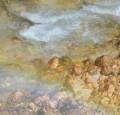
DMT-Nexus member

Posts: 823 Joined: 23-Sep-2017 Last visit: 05-Feb-2024
|
So there is this issue around since long time: Does adding salt into a basic soup enhance the extraction of DMT with an NPS?Now I thought let's give it a try if it would show any real difference. To not use a too big amount of material (of course one may retrieve it back, anyways ...) I just use a smaller amount. The smaller the material count, the bigger the errors of course, so this was just a rough test, which should still show if there is ANY difference, but the total magnitude of a potential difference should not be taken too seriously. Method - preparation of 2 equivalent samples: 1. 200 mg Spice in 50 ml Acetic Acid 2. Addition of 1 g NaOH to basify 3. dissolving 2,4 g NaCl in ONE of the 2 samples (ratio retrieved from Max ION TEK) 4. heating samples to 40 °C and extracting with 1 pull of 25 ml Naphtha for 5 min with a magnetic stirrer Then the Naphtha was separated immediately and evaporated. DMT was scraped and weighted. Only 40 °C was used to avoid pulling all the DMT in the first pull, making any difference impossible to tell. Not-salted:
99 mg (of 200 mg) DMT extracted with 1st Pull
Salted:
102 mg (of 200 mg) DMT extracted with 1st Pull Now as I only used a very small amount of material, there should be a big error, as I could only weight the scraped material and everything that still sticked in traces to the walls could not be measured. So give it a rough +- 2 mg for the final measurement. Considering that I may say: there is practically no difference between both methods. I mean ... if salting would indeed make a difference, then we would see something like 110:100 or 130:100. But the amounts gathered by both methods are in my opinion just in the error range of the method that I used. Possibly one could make a test with 2 g DMT each instead of 0,2 g. But so far I think it's safe to say that salting does not cause a significant improvement. There is even a reason to avoid it: If you want to enhance the pulling step by concentration your solution even more, then you will even crash out stuff from your soup when adding salt. This will cause your soup to become like honey and impossible to extract from. That's just a worst-case scenario, but therefore I dont see any good point in adding salt. Maybe it may help avoiding emulsions, but a well filtered acetic soup wont form emulsions anyways and using vibration is much more effective to get rid of these. This was just 1 test and 1 measurement tells nothing about any statistical trends, but for me this is already enough to make me believe I have an answer now. Maybe other people may also try with different setups and check what they get, so there may be a final answer to this.
|
|
|
|
|

DMT-Nexus member
Posts: 545 Joined: 02-Dec-2017 Last visit: 07-Jun-2025 Location: right side of the river
|
I did some basic experiments with this, but not side by side tests, so got not very conclusive results.
But it seemed that salt slightly improved the yield in second and third pulls, not very much in the first pull.
Would be great to finally have answer to this question.
|
|
|

DMT-Nexus member

Posts: 823 Joined: 23-Sep-2017 Last visit: 05-Feb-2024
|
But if it had an effect, then why shouldnt it be visible on the first pull  Should be affecting any stage of a NPS extraction so I was just doing the first pull as this one will also give the highest yield and therefore least calculation error when scraping stuff apart.
|
|
|

DMT-Nexus member
Posts: 545 Joined: 02-Dec-2017 Last visit: 07-Jun-2025 Location: right side of the river
|
Could it be that salt effect is more prominent when alkaloids concentration is lower?
However, I can confirm that effect of salt on yield is definitely not strong.
|
|
|

In the gap between thoughts nonconceptual wisdom shines continuously.
Posts: 207 Joined: 16-Sep-2017 Last visit: 11-Mar-2024 Location: ⚗ alembic ⚗
|
Thanks for sharing this! Good to know. 
|
|
|

DMT-Nexus member
Posts: 373 Joined: 17-Mar-2019 Last visit: 15-Feb-2024
|
Thanks for taking the time to experiment and the info, very interesting. I also would like to know if you get any difference after several pulls. Thx brennende wasser for your efforts.
|
|
|

❤️🔥
 
Posts: 3648 Joined: 11-Mar-2017 Last visit: 15-Dec-2025 Location: 🌎
|
When you say acetic acid, do you mean a 5% solution?
|
|
|

DMT-Nexus member

Posts: 823 Joined: 23-Sep-2017 Last visit: 05-Feb-2024
|
Quote:When you say acetic acid, do you mean a 5% solution? Actually no idea, I did it some weeks ago and forgot about details   At first I used 25 % concentrated acetic acid, but then I had to throw in way too much NaOH, which already raised the salt concentration on its own very much, so the total difference between salted and "not salted" could have been too low. Then I think I either used 5 % acetic acid or I used my pH 3 HCl-solution, I'm not quite sure actually thinking about it for now  Quote:Could it be that salt effect is more prominent when alkaloids concentration is lower? Well theoretically that is not answered by just 1 pull, but nevertheless I would except these effects to be fully linear and proportional to all of the used conditions. In Biochemistry there may be some wild alterations of effects upon small concentration changes, thats how enzymes / proteins / ... work, but only using basic chemicals and manipulating the partition coefficient of a molecule between 2 solvents I would not expect this effect to suddenly change when changing concentrations - like doing multiple pulls 
|
|
|

In the gap between thoughts nonconceptual wisdom shines continuously.
Posts: 207 Joined: 16-Sep-2017 Last visit: 11-Mar-2024 Location: ⚗ alembic ⚗
|
Brennendes Wasser said: Quote:At first I used 25 % concentrated acetic acid, but then I had to throw in way too much NaOH, which already raised the salt concentration on its own very much
I was thinking exactly that. There's already quite some salt in the basic soup, especially if a lot of acid was used when making water extract. One would have to work with minimal amounts of acids and bases for the extraction to happen and compare that to the additionally salted soup.
|
|
|

DMT-Nexus member

Posts: 823 Joined: 23-Sep-2017 Last visit: 05-Feb-2024
|
Of course one could also just use Bufotenine Fumarate, dissolve at pH 7 and then add base. That would make the salt effect of the Base minimal. But the question is whether in a normal extraction TEK the salting has an impact or not. And all normal salting TEKs either start with pH 3 acidic soups, so I guess by using my pH 3 acidic solution that mimics the regular extraction conditions quite nicely. Also as pH is a logarithmic thing, base that needs to be added to pH 13 is muuuch more than the base required to get from 3 to 7. In the case of 25 % concentrated accetic acid it would be very much - but when using pH 3 water it is negligible compared to basifying from pH 7 onwards. Yo Triglav I was in Triglav narodni park quite a few times   
|
|
|

DMT-Nexus member

Posts: 267 Joined: 14-Dec-2018 Last visit: 14-Apr-2024
|
Adding lye to vinegar indeed "salts" the water with sodium acetate.
If I understand it correctly, salting increases the density of the aqueous layer. That should help reduce emulsions (the lighter-than-water solvent will separate from the water more easily and quickly) and make the separation area less contaminated. However, adding more lye should have the same effect on the density.
Salting also decreases the solubility of DMT (and, alas, impurities) in water (the salt "takes space" between water molecules, leaving "less space" for DMT) - but the solubility of DMT freebase in water is already very poor.
Finally, salting could dehydrate the organic solvent and prevent it from picking up some water and water-soluble impurities like lye. Adding more lye is likely to accomplish the same.
So, I am not sure salting is worth the hassle. With salting it is good to remember that salts can act as pH buffers, so it is important to double-check that the pH is still around ~13 after all the salt and lye have dissolved.
|
|
|

DMT-Nexus member

Posts: 267 Joined: 14-Dec-2018 Last visit: 14-Apr-2024
|
Here's another myth to bust (or confirm).
Some Nexus users complained about the "harshness of their DMT smoke", believing it contained lye particles that got picked up with water droplets and crystallized with the DMT. The usual responses are "NaOH is too high-boiling" or "do a (carbonate) water wash or re-X from heptane".
Just how much water can get trapped in the solvent in the worst case? One way I can think of measuring that is adding the same amount of anhydrous MgSO4 (or similar drying agent) into 2 beakers containing the same amount of solvent. One beaker would be filled with the solvent already pre-dried (for control), the other will be filled with the solvent that has been magnetically stirred with water. After a few hours the solvents can be decanted or filtered off, and the drying agents can be dried at room temperature to constant weight and their weights can be compared.
|
|
|

DMT-Nexus member

Posts: 823 Joined: 23-Sep-2017 Last visit: 05-Feb-2024
|
True that - its a pretty senseless concern   NaOH boils at super high temperatures, but it is also totally 0 soluble in Naphtha. If there are no black droplets from the aqueous soup then there is no water spilled over into the Naphtha, making the amount of NaOH exactly 0. Quote:One way I can think of That would be quite cool! And not too complicated to conduct. But in any case even if there might be a few ml water: The water would not be present in a condensed state like regular liquid water, but more something like being dissolved in the other solvent, with all the molecules having a big distance to each other. In that state it cannot dissolve anything that would normally be dissolved in water right away. So probably even if this could happen (and I think it's permitted by the giant difference of logP) the water may not dissolve any goods 
|
|
|

DMT-Nexus member

Posts: 267 Joined: 14-Dec-2018 Last visit: 14-Apr-2024
|
Brennendes Wasser wrote:True that - its a pretty senseless concern   NaOH boils at super high temperatures, but it is also totally 0 soluble in Naphtha. If there are no black droplets from the aqueous soup then there is no water spilled over into the Naphtha, making the amount of NaOH exactly 0. This article says that tools, technique and impurities can make it non-zero: "Drying agents must be used with even relatively nonpolar organic solvents that do not theoretically dissolve much water, as water may cling to the sides of the separatory funnel and inadvertently travel with the organic layer while draining. Additionally, solutes dissolved in an organic layer with polar functional groups (e.g. alcohols, carboxylic acids) can hydrogen-bond with water and increase the likelihood of water dissolving in the organic layer."While NaOH is indeed too high-boiling to vaporize with DMT, I can only imagine what kind of other gunk people may have in their bark, water, lye, naphtha, etc. so I still wonder if it makes sense to recommend drying the NPS with CaCl2 or CaSO4 granules to scoop up any residual water and the impurities stuck to it.... Quote:But in any case even if there might be a few ml water: The water would not be present in a condensed state like regular liquid water, but more something like being dissolved in the other solvent, with all the molecules having a big distance to each other. In that state it cannot dissolve anything that would normally be dissolved in water right away. So probably even if this could happen (and I think it's permitted by the giant difference of logP) the water may not dissolve any goods  I don't know. The same article above claims: "Aqueous solutions of saturated sodium bicarbonate (NaHCO3) and sodium carbonate (Na2CO3) are basic, and the purpose of these washes is to neutralize an organic layer that may contain trace acidic components. Even if an organic layer should not in theory dissolve very polar components such as acid, acid sometimes "hitches a ride" on polar components that may dissolve in an organic layer, such as small amounts of alcohols or water."
|
|
|

DMT-Nexus member

Posts: 823 Joined: 23-Sep-2017 Last visit: 05-Feb-2024
|
Quote: Additionally, solutes dissolved in an organic layer with polar functional groups (e.g. alcohols, carboxylic acids) can hydrogen-bond with water and increase the likelihood of water dissolving in the organic layer. That may indeed a problem, but at least for Naphtha there are none of these water dragging groups. I think none of the most used NPS have these: Hexane/Heptane, Xylene, Limonene Still I think as the water molecules are then totally dispersed all throughout the NPS, they cannot form any solvation layer around other molecules, making them unable to dissolve stuff that water would dissolve. Still thats just a theory and it would be interesting to indeed check the weight of a drying agent that was stirred in NPS, which came in contact with Water first. Let's say if 1 L of NPS only contained 10 ml of water, then this 10 ml would only contain µg amounts of lye and this amount distributed in 1 L of NPS. Then upon decanting an NPS via freeze precip, then let's say 0,01 % of NPS still sticks to the crystals and upon evaporating leaving behind practically 0 µg of NaOH. But still, thats only theoretical stuff without any real data. 
|
|
|

❤️🔥
 
Posts: 3648 Joined: 11-Mar-2017 Last visit: 15-Dec-2025 Location: 🌎
|
I think salting out does help. It is what I've noticed. Also seems to clear up emulsions which allows for more shaking and that helps yields too. I don't have hard data, just confirmed and moved on since it seemed already well established anyway. I believe I've seen data before on the nexus. I think it was even more impressive for mescaline if I remember correctly. One thing that has not been explored much (from what I can see) and would be an open question to look into is is sugaring out, or combining salt/sugar. Viscosity may be an issue with sugar - or it may help with "dryteks" where solvent is poured off and a thick alkaline water/plant paste is left behind.
|